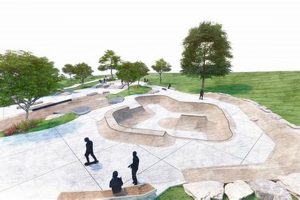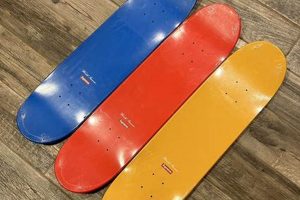Clothing and accessories designed specifically for skateboarding constitute a significant segment of the action sports market. This category encompasses items such as durable pants, graphic t-shirts, comfortable hoodies, and specialized footwear engineered to withstand the rigors of skating. Examples include reinforced denim jeans, shirts featuring skate-related imagery, warm hooded sweatshirts for varying weather conditions, and shoes with enhanced grip and impact absorption.
The availability of purpose-built garments contributes significantly to both the safety and performance of skateboarders. Durable materials minimize the risk of injury during falls, while functional designs allow for unrestricted movement. Historically, the evolution of this specialized attire reflects the growth and professionalization of skateboarding, moving from repurposed casual wear to technically advanced products that meet the specific demands of the sport. The development has fostered a sense of identity and belonging within the skateboarding community.
The following sections will delve into the specific characteristics of key items within this apparel segment, exploring their materials, construction, and design features, as well as their impact on the overall skateboarding experience. The examination includes analyses of fabric choices, manufacturing techniques, and the role of design in both functionality and aesthetics within this context.
Essential Considerations for Optimal Skateboarding Attire
Selecting the appropriate clothing and accessories can significantly enhance the skateboarding experience, promoting both safety and performance.
Tip 1: Prioritize Durability. Opt for garments constructed from robust materials such as reinforced cotton, canvas, or denim. These fabrics withstand abrasion and minimize the risk of tears during falls.
Tip 2: Ensure Freedom of Movement. Choose items with a relaxed fit that allows for unrestricted articulation. Avoid restrictive clothing that hinders the execution of tricks or maneuvers.
Tip 3: Consider Protective Features. Explore apparel incorporating integrated padding or reinforced panels in high-impact areas like knees and elbows. This offers an additional layer of protection against injuries.
Tip 4: Select Moisture-Wicking Fabrics. Opt for materials that effectively draw moisture away from the body, keeping the wearer cool and comfortable during extended skateboarding sessions.
Tip 5: Pay Attention to Footwear Design. Prioritize shoes with flat, grippy soles and reinforced construction. These features provide optimal board feel and support, enhancing control and stability.
Tip 6: Layer Strategically. Adjust attire based on environmental conditions by incorporating layers. This allows for adaptability to changing temperatures and weather patterns.
Tip 7: Evaluate Stitching Quality. Examine the stitching and seams for robustness. Reinforced stitching enhances garment longevity and prevents premature wear and tear.
Adhering to these guidelines promotes a safer and more enjoyable skateboarding experience. Prioritizing durability, freedom of movement, and protective features maximizes comfort and reduces the risk of injury.
The subsequent section will explore specific product categories and provide detailed insights into their respective benefits and features.
1. Durability
Durability constitutes a foundational requirement for skateboard apparel, directly impacting its longevity and protective capabilities. The inherent demands of skateboarding, characterized by repetitive abrasive contact with concrete and frequent falls, necessitate the use of robust materials and construction techniques. Clothing that lacks durability is prone to rapid wear, tears, and seam failures, rendering it ineffective and potentially unsafe. A direct consequence of insufficient durability is the increased frequency of replacement, resulting in higher costs for the skateboarder. Consider denim jeans reinforced with double-stitched seams, specifically designed to withstand the friction generated during slides and grinds. These garments exemplify how enhanced durability directly translates to improved performance and safety. The absence of such features would render typical casual wear unsuitable for skateboarding activities.
The selection of durable materials, such as heavy-duty cotton twill, canvas, and abrasion-resistant synthetics, forms the first line of defense against wear and tear. The incorporation of reinforced panels in high-stress areas, such as the knees and seat of pants, further enhances durability. Stitching techniques also play a crucial role, with double and triple stitching employed to fortify seams and prevent separation. Furthermore, design considerations, such as gusseted crotches and articulated knees, reduce stress on seams during movement, contributing to overall garment longevity. A failure to address these aspects results in apparel that is quickly damaged, exposing the skater to potential injuries and incurring additional expenses for replacements. For instance, jackets constructed with tear-resistant nylon are more resistant to damage from falls than those made from lighter, less durable fabrics.
In summary, durability is not merely a desirable attribute of skateboarding apparel, it is a prerequisite for functionality and safety. The use of robust materials, reinforced construction, and thoughtful design contributes to the garment’s ability to withstand the rigors of skateboarding. Neglecting this aspect can result in premature wear, increased risk of injury, and ultimately, a less satisfactory skateboarding experience. The understanding and prioritization of durability are therefore crucial for both manufacturers and consumers seeking to optimize the performance and longevity of skateboarding apparel.
2. Functionality
Functionality, in the context of skateboarding apparel, transcends mere aesthetics, encompassing the design elements that directly contribute to a skateboarder’s performance, safety, and comfort. Garments must facilitate unrestricted movement, provide protection against the elements and impacts, and enhance the overall skateboarding experience. The integration of functional features is therefore a critical consideration in the design and manufacturing.
- Range of Motion
Skateboarding demands a full range of motion, requiring apparel that does not impede movement during complex maneuvers. Articulated designs, gusseted crotches, and strategically placed stretch panels are incorporated to enhance flexibility and prevent restriction. For instance, pants with a diamond gusset in the crotch allow for greater freedom of leg movement during ollies and other tricks, enhancing performance and reducing the risk of tearing the garment.
- Moisture Management
Physical exertion during skateboarding generates heat and perspiration, necessitating garments with effective moisture-wicking properties. Fabrics such as polyester blends and specialized synthetic materials draw moisture away from the skin, promoting breathability and preventing discomfort caused by sweat accumulation. Examples include t-shirts made from quick-drying fabrics that maintain comfort during prolonged skateboarding sessions.
- Impact Protection
Falls and impacts are inherent to skateboarding, requiring apparel that offers a degree of impact protection. Integrated padding in areas prone to injury, such as knees and elbows, can mitigate the severity of impacts. Jackets and pants with reinforced panels made from durable materials also provide an additional layer of protection against abrasions and cuts. The inclusion of such features reduces the risk of injury and enhances the skateboarder’s confidence.
- Weather Resistance
Skateboarding is an outdoor activity often performed in varying weather conditions, making weather resistance a significant functional consideration. Jackets and pants designed with water-resistant or waterproof materials provide protection from rain and wind, allowing skateboarders to continue their activity in inclement weather. Examples include hooded jackets with a durable water repellent (DWR) finish that shields the wearer from light rain and wind.
The functional attributes discussed are fundamental to apparel. Without proper consideration, a garment may be aesthetically appealing but ultimately unsuitable for the demands of skateboarding. The thoughtful integration of these elements enhances performance, comfort, and safety, making these garments essential components of a skateboarder’s equipment.
3. Protection
Safety considerations are fundamental in the design and construction of skateboarding apparel. The inherent risks associated with the sport necessitate garments engineered to mitigate potential injuries. Protective features are integral to skateboarding garments, directly influencing their usability and overall value.
- Impact Absorption
Impact absorption is crucial for minimizing injury severity from falls. Padding strategically integrated into apparel, such as in knee and elbow areas, disperses impact forces, reducing the likelihood of contusions, fractures, and other trauma. Examples include pants with internal knee pad pockets accommodating removable protective inserts. The effectiveness of impact absorption directly correlates with the materials used and the design of the padding.
- Abrasion Resistance
Abrasive contact with surfaces like concrete and asphalt is common during skateboarding. Apparel constructed with high abrasion resistance protects the skin from scrapes, cuts, and burns. Durable fabrics, such as reinforced denim and canvas, withstand friction more effectively than lighter materials. The selection of abrasion-resistant materials directly affects the garment’s longevity and protective capability.
- Joint Support
Providing support to joints, especially ankles and wrists, minimizes the risk of sprains and strains. High-top skate shoes offer ankle support through reinforced collars and structured designs. Wrist guards, often worn separately, can be integrated into gloves or sleeves. Adequate joint support enhances stability and reduces the potential for acute or chronic injuries.
- Visibility Enhancement
Increasing visibility improves safety in low-light conditions or high-traffic areas. Reflective elements incorporated into apparel, such as logos or piping, enhance the wearer’s visibility to motorists and pedestrians. Brightly colored garments also improve visibility during daylight hours. Enhancing visibility reduces the risk of collisions and accidents.
The integration of these protective elements transforms standard clothing into specialized skateboarding apparel. These features contribute significantly to skater safety and comfort, justifying investment in high-quality, purpose-built garments. Prioritizing these protective aspects ensures a safer and more enjoyable skateboarding experience.
4. Aesthetics
Aesthetics play a crucial role in the selection and perception of skateboarding apparel. Beyond mere functionality and protection, the visual appeal of garments contributes significantly to a skateboarder’s identity, confidence, and connection to the skateboarding culture. The design and visual elements of this clothing reflect evolving trends, personal expression, and brand affiliation.
- Graphic Design and Imagery
Graphic design and imagery are central to skateboarding apparel aesthetics. T-shirts, hoodies, and even pants often feature bold graphics, logos, and artwork that convey messages, express personal style, or represent specific skateboarding brands and subcultures. For instance, a shirt featuring a vintage skateboarding logo evokes a sense of nostalgia and affiliation with the sport’s history. The use of striking visuals can enhance brand recognition and create a sense of community among skateboarders.
- Color Palette and Pattern
The color palette and pattern choices in skateboarding apparel influence its overall visual impact and appeal. Bold, contrasting colors can create a dynamic and eye-catching look, while muted tones and minimalist designs offer a more subtle and understated aesthetic. Patterns, such as stripes, camouflage, or abstract designs, add visual interest and personality to garments. Examples include the use of vibrant colors and geometric patterns in skateboard shoe designs to attract attention and express individuality.
- Silhouette and Fit
The silhouette and fit of skateboarding apparel contribute significantly to its aesthetic appeal. Loose-fitting garments, such as baggy pants and oversized hoodies, are often favored for their comfort and association with skateboarding culture. However, more streamlined and athletic silhouettes are also prevalent, reflecting a shift towards performance-oriented apparel. The choice of silhouette and fit depends on individual preferences and the desired aesthetic expression.
- Brand Identity and Logos
Brand identity and logos play a significant role in shaping the aesthetics of skateboarding apparel. Prominent display of brand logos on garments creates brand recognition and signals affiliation with specific skateboarding companies. The design and placement of logos contribute to the overall visual identity of the apparel and the brand itself. For example, a strategically placed logo on a t-shirt or hat instantly identifies the wearer as a supporter of that brand and its values.
The interplay of graphic design, color palette, silhouette, and brand identity shapes the aesthetics of skateboarding apparel. The visual elements contribute to personal expression and a sense of belonging, while also reflecting the broader trends within the subculture. These aesthetic considerations are essential for brands to capture consumer attention and solidify their presence within the skateboarding community.
5. Brand Identity
Brand identity is a critical component of skateboarding apparel. It transcends the mere application of logos; it embodies the values, history, and ethos of a particular company. Brand identity influences consumer perception, fostering loyalty and distinguishing products within a competitive market. A strong brand identity in skateboarding apparel resonates with the subculture’s values of individuality, rebellion, and authenticity. For example, brands with a history deeply intertwined with skateboarding culture often hold more influence and credibility than newcomers solely focused on profit.
The impact of brand identity on consumer purchasing decisions within skateboarding is substantial. Skateboarders frequently select apparel that aligns with their personal identity and reflects the image they wish to project. Garments bearing the logos of established brands known for quality and innovation serve as a visible endorsement of those attributes. Conversely, a poorly defined or inauthentic brand identity can lead to consumer skepticism and decreased sales. The case of certain apparel lines associated with professional skaters illustrates this point; positive perceptions of the skater translate directly into brand recognition and sales.
Understanding the significance of brand identity in the skateboarding apparel sector is practically important for both manufacturers and consumers. Manufacturers can leverage a well-crafted brand identity to cultivate customer loyalty and differentiate their products. Consumers benefit from a clear understanding of brand values, enabling them to make informed purchase decisions that align with their own preferences and values. While challenges remain in maintaining authenticity and adapting to evolving trends, a robust brand identity remains essential for long-term success in the skateboarding apparel market.
Frequently Asked Questions
The following section addresses common inquiries regarding garments and accessories designed for skateboarding. These responses provide objective information to aid in informed decision-making.
Question 1: What constitutes “element skate apparel”?
This term denotes a range of clothing and accessories specifically engineered for the demands of skateboarding. Key characteristics include durability, freedom of movement, and protective features.
Question 2: Why is specialized clothing necessary for skateboarding?
Standard clothing often lacks the robustness and design features required to withstand the rigors of skateboarding. Specialized garments provide enhanced protection against abrasions and impacts, while facilitating unrestricted movement crucial for performing tricks.
Question 3: How does “element skate apparel” enhance safety?
Features such as reinforced fabrics, padded inserts, and supportive footwear minimize the risk of injuries associated with falls and abrasive contact with surfaces.
Question 4: What materials are typically used in its construction?
Durable materials like reinforced cotton, canvas, denim, and synthetic blends are frequently employed to ensure longevity and resistance to wear and tear.
Question 5: How does its design impact performance?
Articulated designs, gusseted crotches, and strategically placed stretch panels allow for a full range of motion, enhancing a skateboarder’s ability to execute maneuvers effectively.
Question 6: Where can genuine “element skate apparel” be purchased?
Authentic products are available through authorized retailers, specialized skate shops, and reputable online vendors. Verifying the authenticity of the source is crucial to ensure quality and performance.
In summary, specialized clothing and accessories provide demonstrable benefits in terms of safety, performance, and durability. Selecting appropriate garments enhances the overall skateboarding experience.
The subsequent section will explore the future trends and innovations in the skateboarding apparel industry.
Element Skate Apparel
This exploration of element skate apparel has underscored its multifaceted nature, extending beyond mere articles of clothing to encompass essential tools for performance, safety, and self-expression within the skateboarding subculture. Durability, functionality, protection, and aesthetics each contribute significantly to the overall value proposition of these specialized garments. Brand identity further solidifies the relationship between manufacturer and consumer, fostering loyalty and community engagement.
The continued innovation and refinement of garments will inevitably shape the future of skateboarding. A deeper understanding of material science, biomechanics, and design principles will likely yield further enhancements in both performance and protection. The choices made by skateboarders regarding their apparel reflect a commitment to the sport and a desire to maximize its potential, emphasizing the enduring significance of well-designed and conscientiously manufactured clothing and accessories. Continued diligence in product development and consumer education remains paramount.







